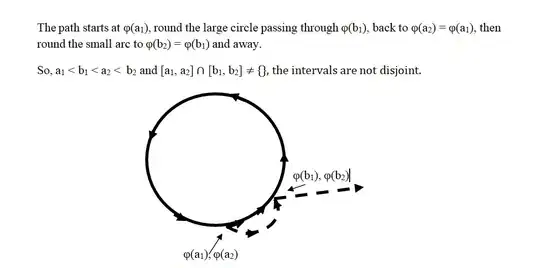I am struggling to prove the following intuitive result:
Take $\phi:[a,b]\rightarrow \mathbb{R}^{n}$ a continuous mapping with $\phi(a)\neq\phi(b)$. Then there is a continuous injective mapping $\phi_{0}$ with image contained in $\phi([a,b])$ such as $\phi_{0}(a)=\phi(a)$ and $\phi_{0}(b)=\phi(b)$.
I found this statement in Falconer, The geometry of fractal sets, with a sadly incorrect proof, which went as follows.
"Take the collection $\mathcal{C}$ of proper intervals $I_{x}$ of the form $[t_{1},t_{2}]$ with $\phi(t_{1})=\phi(t_{2})=x$ who are contained in no other intervals of the same form. Since it is a collection of countably many proper disjoint closed intervals, we can find a continuous surjective increasing function $f:[a,b]\rightarrow [a,b]$ such as $f(t_{1})=f(t_{2})$ if and only if $t_{1}=t_{2}$ or if $t_{1},t_{2}$ are in a same interval of $\mathcal{C}$. Then it is easy to check that $\phi_{0}$, defined by $\phi_{0}(u)=x$ if $f^{-1}(u)=I_{x}$ and $\phi_{0}(u)=\phi(f^{-1}(u))$ otherwise, satisfies our requirements."
The problem with that proof is that though the intervals of $\mathcal{C}$ are indeed proper and closed, they are not necesarily disjoint. I can't reproduce the drawing here but it is not too difficult to show a curve in $\mathbb{R}^{2}$ with two double points $x,y$ such as $\phi(a_{1})=\phi(a_{2})=x$, $\phi(b_{1})=\phi(b_{2})=y$, and $a_{1} < b_{1} < a_{2} < b_{2}$.
I don't know how to complete the proof (I even tried with Zorn's lemma), if you have any ideas they are welcome.
Here's a diagram ...
Since the intervals are not necessarily disjoint they aren't necessarily countable either.
